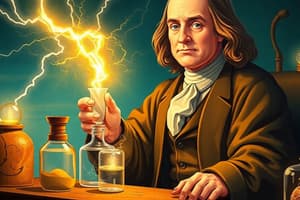Podcast
Questions and Answers
Franklin developed a method utilizing a ______ and bypassed the idea centuries before windsurfing.
Franklin developed a method utilizing a ______ and bypassed the idea centuries before windsurfing.
sail
At the age of 11, Franklin crafted early versions of what we now recognize as ______.
At the age of 11, Franklin crafted early versions of what we now recognize as ______.
swim fins
Franklin's greatest contributions lie in the realm of ______.
Franklin's greatest contributions lie in the realm of ______.
electricity
Franklin played a crucial role in developing the concepts of ______ and ______ charges.
Franklin played a crucial role in developing the concepts of ______ and ______ charges.
The ______ remains a staple of modern architecture, demonstrating Franklin's foresight in understanding the importance of safety measures against natural phenomena.
The ______ remains a staple of modern architecture, demonstrating Franklin's foresight in understanding the importance of safety measures against natural phenomena.
Benjamin Franklin, a renowned figure of the ______ of Enlightenment, was indeed a man of extraordinary talents.
Benjamin Franklin, a renowned figure of the ______ of Enlightenment, was indeed a man of extraordinary talents.
Franklin was propelled to become an accomplished ______, author, inventor, statesman, and a founding father of the United States.
Franklin was propelled to become an accomplished ______, author, inventor, statesman, and a founding father of the United States.
Franklin, a ______-taught scholar, started his journey towards self-education at a young age.
Franklin, a ______-taught scholar, started his journey towards self-education at a young age.
At the age of 17, Franklin embarked on a ______ to Philadelphia, where he found employment as a printer.
At the age of 17, Franklin embarked on a ______ to Philadelphia, where he found employment as a printer.
Franklin quickly established his own newspaper, 'The ______ Gazette,' and formed a partnership with Hugh Meredith.
Franklin quickly established his own newspaper, 'The ______ Gazette,' and formed a partnership with Hugh Meredith.
Flashcards are hidden until you start studying
Study Notes
Benjamin Franklin: A Polymath of Invention and Discovery
Introduction
Benjamin Franklin, a renowned figure of the Age of Enlightenment, was indeed a man of extraordinary talents. Born on January 17, 1706, in Boston, Massachusetts, he grew up amidst the bustling atmosphere of the colonial era. Despite his humble beginnings as the tenth son of a soap maker, Franklin was propelled to become an accomplished polymath, author, inventor, statesman, and a founding father of the United States. His contributions to science, particularly in the field of electricity, are legendary.
Early Life and Education
Franklin, a self-taught scholar, started his journey towards self-education at a young age. By the time he reached 12, he had already begun working as an apprentice in his elder brother James's print shop. This job afforded him unfettered access to books and ideas, and he consumed them with enthusiasm. He continued his education in earnest, teaching himself to read, write, and calculate numbers.
At the age of 17, Franklin embarked on a voyage to Philadelphia, where he found employment as a printer. He quickly established his own newspaper, "The Pennsylvania Gazette," and formed a partnership with Hugh Meredith. This venture prospered, enabling Franklin to diversify his business interests and establish a printing company.
Inventions and Discoveries
Throughout his life, Franklin demonstrated an insatiable curiosity, often applying the scientific method set out by Isaac Newton and others. His fascination with natural phenomenon led him to explore numerous fields, from nautical inventions to experiments with electricity.
One of his earliest inventions was related to swimming. Recognizing the need for aid while navigating water, he developed a method utilizing a sail and bypassed the idea centuries before windsurfing. Additionally, at the tender age of 11, he crafted early versions of what we now recognize as swim fins. These innovations have secured him a place in the International Swimming Hall of Fame.
As an adult, Franklin voyaged across the Atlantic eight times, which presented him with opportunities to observe the ocean and weather. This knowledge led him to imagine ways to streamline ships for quicker and more comfortable travel.
However, Franklin's greatest contributions lie in the realm of electricity. He was drawn to the intrigue of static charges and undertook rigorous investigations to grasp its potential applications. Perhaps his most iconic demonstration was flying a kite in a thunderstorm with a metal key attached to the line, successfully capturing electrical charge from the surrounding clouds in a Leyden jar.
This experiment, along with his subsequent observations, proved conclusively that lightning itself was an electrical discharge. Moreover, Franklin played a crucial role in developing the concepts of positive and negative charges, adding significantly to the burgeoning field of electrostatics.
Another invention that bears Franklin's name is the lightning rod, designed to protect structures from devastating strikes by intercepting the charge and conducting it safely to the ground. The lightning rod remains a staple of modern architecture, demonstrating Franklin's foresight in understanding the importance of safety measures against natural phenomena.
Conclusion
Benjamin Franklin's life embodies the spirit of innovation, curiosity, and the quest for knowledge. From his humble beginnings as an apprentice printer to his influential role as one of America's founding fathers, he left behind a legacy that transcends time. His contributions to science, particularly in electricity, have stood the test of time and continue to resonate profoundly with scientists and engineers alike.
Studying That Suits You
Use AI to generate personalized quizzes and flashcards to suit your learning preferences.




